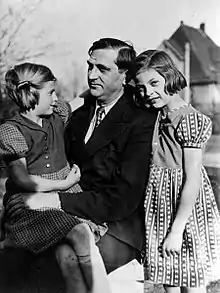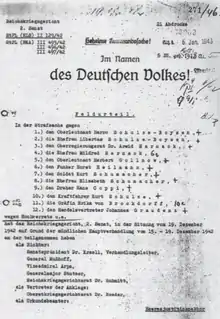John Graudenz
Wolfgang Kreher Johannes "John" Graudenz (12 November 1884 – 22 December 1942) was a German journalist, press photographer, industrial representative and resistance fighter.[1] Graudenz was most notable for being an important member of the Berlin-based anti-fascist resistance group[2] that would later be named by the Gestapo as the Red Orchestra and was responsible for the technical aspect of the production of leaflets and pamphlets that the group produced.[3]
John Graudenz | |
|---|---|
 Graudenz with his daughters, Karin and Silva | |
| Born | 12 November 1884 |
| Died | 22 December 1942 (aged 58) |
| Cause of death | Execution by strangulation at Plötzensee Prison |
| Nationality | German |
| Known for | Being a core member of the Schulze-Boysen group |
Family
Graudenz was the son of a saddler,[4] and came from a large family with 10 siblings.[4]
Graudenz was married three times and also had an illegitimate daughter. In 1925 he married Antonie "Toni" Graudenz née Wasmuth († 1985), his third wife who was the daughter of the art publisher Ernst Wasmuth. Together they had two children, Silva and Karin.
Life
In 1901 at the age of seventeen Graudenz left the family home after a quarrel with the father, to work in various German cities before travelling to England via Italy, France and Switzerland.[1] He worked as a waiter, tourist guide and hotel manager and learned a number of different languages before arriving in Berlin in 1908.[4] In 1916 Graudenz started journalistic his career as an assistant to the Berlin correspondent of the United Press International and in the same year took over responsibility of the management of the Berlin office of United Press.[4] In March 1920 Graudenz was involved in the Kapp Putsch that took place in Berlin and was an attempt to overthrow the Weimar Republic. At the time Graudenz worked in the information office of the coup's opponents and became a comrade-in-arms of the opponents of the coup and for a short time was a member of the Communist Workers' Party of Germany (German: Kommunistische Arbeiter-Partei Deutschlands; KAPD).[1] It is even possible that he was a founding member of the KAPD.[4] In 1921 he was posted to the Soviet Union and wrote favourably of Lenin as a journalist for the United Press agency in Moscow. In 1924 he was the first to report the death of Lenin in America.[5]
In 1924 Graudenz organised a Steamboat River cruise along the Volga River along with a group of journalists where they discovered the desolate and famine-stricken state of the Soviet Union.[5] The Russians were angered by the photographs taken while on the cruise and expelled Graudenz.
From 1932, Graudenz worked as an industrial representative.[1] Later during the interwar period and into the war, he worked in a similar position where he sold brake parts for Luftwaffe aircraft.[6]
Red Orchestra

In 1938 Graudenz met the Luftwaffe officer and anti-fascist Harro Schulze-Boysen through his neighbour, the supposed fortune-teller and clairvoyant, Anna Krauss who also owned a lacquer and paint wholesaler.[7] Graudenz became one the member's of the anti-fascist resistance group of friends that was led by Schulze-Boysen and that would be later be named by the Gestapo as the Red Orchestra.[5] Shulze-Boysen's wife Libertas Schulze-Boysen was a client of Annie Krauss, who herself would go on to become part of the group by using her apartment to host two mimeograph machines to produce leaflets with Graudenz running the operation.[8]
Graudenz became one of the core members of the group and was considered by Schulze-Boysen as one of his most valuable informants,[9] who had many contacts in the German aviation industry.[4] As well as providing intelligence for the group, Graudenz's skills led to the production of a large number of propaganda leaflets and pamphlets for the group.[9] In February 1942, Graudenz organised the preparation and production of the leaflet called The concern for Germany's future goes through the people German: Die Sorge um Deutschlands Zukunft geht durch das Volk.[1]
In the spring of 1942, Schulze-Boysen had discovered that Germany had found and deciphered several British codebooks that enabled them to chart the routes of several Allied convoys between Iceland and Northern Russia and were planning a large attack involving Luftwaffe aircraft, Kriegsmarine U-boats and the battleship Tirpitz.[10] Shulze-Boysen was keen to inform the Allies. It was through Graudenz that Marcel Melliand, a left-wing textile magazine owner and businessman with good contacts in Switzerland became known to Schulze-Boysen.[10] Schulze-Boysen asked Graudenz to establish a link with a contact in Switzerland through Melliand and both Graudenz and Melliand agreed.[9] The Melliand contact was tried in August 1942 when Shulze-Boysen instructed Graudenz to ask Melliand to make the trip. The complete schedule of operations of the convoy was included in the intelligence report. However, the report did not reach England as Melliand was unable to obtain a permit for the trip.[9]
Graudenz continued to produce political, military and economic reports for the resistance group. Graudenz worked for the firm, Blumhardt of Wuppertal that produced aircraft undercarriages and this enabled him to obtain information from a wide group of business and personal contact within the Nazi Ministry of Aviation.[9] His most important report that he obtained through Hans Gerhard Henniger, an air ministry inspector was the Luftwaffe aircraft production figures for June to August 1942.[9]

In mid-May 1942, Joseph Goebbels held a Nazi propaganda exhibition called The Soviet Paradise (German original title "Das Sowjet-Paradies"), with the express purpose of preparing the German people for the invasion of the Soviet Union.[11] Graudenz was the initiator the campaign to post adhesive sticker across five Berlin neighbourhoods containing the message:
- Permanent Exhibition
- The Nazi Paradise
- War, Hunger, Lies, Gestapo
- How much longer?[11]
Death
John Graudenz was arrested on 12 September 1942 and sentenced to death by the Reichskriegsgericht on 19 December 1942. Without the verdict gaining legal force under the Nazi laws, he was hanged on 22 December 1942 in the Plötzensee Prison on the orders of Adolf Hitler.[12] Even before the beginning of the oral proceedings of Reichskriegsgericht, the Oberkommando der Wehrmacht i.e. the High Command of the Wehrmacht, ordered strangulation. This was against all the traditions and regulations of the Prussian-German military and civil courts as a method of execution [...] strangulation.[13]
Due to the German idea that the family shares responsibility for a crime, known as Sippenhaft, both John's daughters and his wife were also arrested on the same day. The 2nd senate of the Reichskriegsgericht sentenced Toni Graudenz on 12 February 1943 for listening to enemy broadcasters and refraining from an advising [the state] to three years in prison. Both Karin and Silva were released after two weeks.
Awards
- In Stahnsdorf John Graudenz Street is named after him.
- Also in Stahnsdorf is also a memorial stone for him and Anna Krauss in Anni Krauss Street.
See also
- Literature by and about John Graudenz in the German National Library catalogue
- Works by and about John Graudenz in the Deutsche Digitale Bibliothek (German Digital Library)
- Search for John Graudenz in the SPK digital portal of the Prussian Cultural Heritage Foundation (Stiftung Preußischer Kulturbesitz)
| Wikimedia Commons has media related to John Graudenz. |
References
- "John Graudenz". Gedenkstätte Deutscher Widerstand. German Resistance Memorial Center. Retrieved 25 May 2019.
- Kesaris, Paul. L, ed. (1979). The Rote Kapelle: the CIA's history of Soviet intelligence and espionage networks in Western Europe, 1936-1945. Washington DC: University Publications of America. p. 141. ISBN 0-89093-203-4.
- Corina L. Petrescu (2010). Against All Odds: Models of Subversive Spaces in National Socialist Germany. Peter Lang. p. 233. ISBN 978-3-03911-845-8. Retrieved 3 June 2019.
- "Graudenz, John". Deutsche Fotothek (in German). kue 70048904: Saxon State and University Library Dresden. Retrieved 25 May 2019.CS1 maint: location (link)
- Anne Nelson (7 April 2009). Red Orchestra: The Story of the Berlin Underground and the Circle of Friends Who Resisted Hitle r. Random House Publishing Group. p. 170. ISBN 978-1-58836-799-0. Retrieved 3 June 2019.
- Rodney Carlisle (26 March 2015). Encyclopedia of Intelligence and Counterintelligence. Routledge. p. 546. ISBN 978-1-317-47177-6. Retrieved 16 December 2020.
- Harro Schulze-Boysen (1999). Dieser Tod paßt zu mir (in German). Aufbau-Verlag. p. 412. ISBN 978-3-351-02493-2. Retrieved 15 June 2019.
- Anne Nelson (7 April 2009). Red Orchestra: The Story of the Berlin Underground and the Circle of Friends Who Resisted Hitler. Random House Publishing Group. p. 170. ISBN 978-1-58836-799-0. Retrieved 15 June 2019.
- Kesaris, Paul. L, ed. (1979). The Rote Kapelle: the CIA's history of Soviet intelligence and espionage networks in Western Europe, 1936-1945. Washington DC: University Publications of America. p. 143. ISBN 0-89093-203-4.
- Anne Nelson (7 April 2009). Red Orchestra: The Story of the Berlin Underground and the Circle of Friends Who Resisted Hitler. Random House Publishing Group. p. 171. ISBN 978-1-58836-799-0. Retrieved 14 June 2019.
- Shareen Blair Brysac (12 October 2000). Resisting Hitler : Mildred Harnack and the Red Orchestra: Mildred Harnack and the Red Orchestra. Oxford University Press, USA. p. 300. ISBN 978-0-19-531353-6. Retrieved 28 December 2018.
- Oleschinski, Brigitte. "Gedenkstätte Plötzensee" (PDF) (in German). Gedenkstätte Deutscher Widerstand. Archived from the original (pdf) on 21 October 2013.
- Rosiejka, Gert (1986). Die Rote Kapelle : "Landesverrat" als antifaschist. Widerstand (in German) (1. Aufl ed.). Hamburg: Ergebnisse-Verl. p. 77. ISBN 3-925622-16-0.